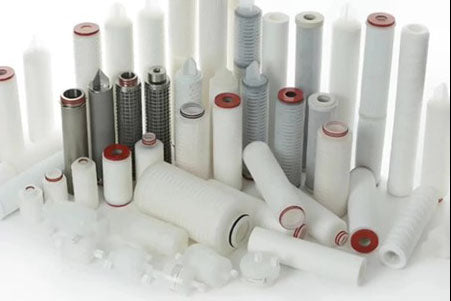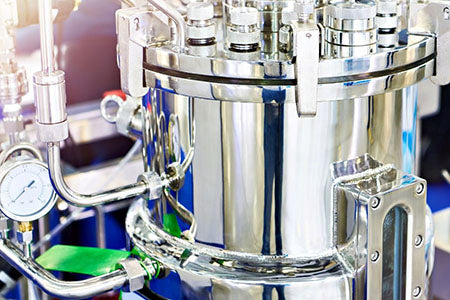
Cartridge filters are an essential tool for several industries that have a goal of filtering impurities out of liquids. Their effectiveness comes down to the filter media, or membrane, used in a given cartridge. With several types of filtration to choose from, not to mention different cartridges, it can be difficult to know which device is best for you. Read on for the different cartridge filter membrane types explained.
Surface Filtration
All filtration processes can be classified into one of two categories: surface filtration and depth filtration. The first type, surface filtration, exists in a type of cartridge filter that keeps larger particles trapped on the surface of the filter medium. You can think of this like pasta in a colander—cooked noodles are left on the inside of the colander while water escapes through holes in the bottom.
Cartridge filters that use surface filtration operate on a much smaller scale, but with the same principle. Some small particles are able to pass through the filter, while debris, contaminants, and other unwanted particles cannot.
This process is most often used when particles are larger and need to be removed from the liquid. You may find surface filtration at work in water treatment plants to separate sand, dirt, and rust from water, or in the food and beverage industry to pull impurities like fiber and sediment from liquid.
Depth Filtration
Depth filtration, on the other hand, is a filtration process that traps particles inside the filter medium. This works because the filter medium is a complexly layered structure of interconnected holes; as liquid passes through, some particles get stuck throughout the filter, unable to pass through.
When particles are a bit smaller than those found in water treatment and the food and beverage industry, like in the pharmaceutical industry, depth filtration is required. In these applications, depth filtration can remove bacteria, viruses, and other tiny particles from a liquid solution.
One benefit of depth filtration over surface filtration is filter capacity and longevity. Because there are so many layers in a filter using depth filtration, it takes longer for the filter to become clogged with particles. This allows you to use a depth filter for more time before replacing it, unlike a surface filter which must be replaced more frequently.
Microfiltration
Now that you know some of the main theories surrounding filtration, let’s discuss more specific types of filter membranes. Microfiltration membranes, which largely use depth filtration, are designed to remove particles from 0.1 to 10 micrometers from solutions. Most of the time, microfiltration is a precursor to ultrafiltration—in other words, microfiltration removes particles would clog up an even smaller filter.
Microscopic particles like water, chloride ions, or small viruses can pass through microfilters, but sediment, algae, and large bacteria cannot.
Ultrafiltration
Ultrafiltration uses pressure to push liquid through the pores of a semipermeable membrane, similar to several other types of filtration we’ve already covered. However, ultrafiltration separates itself from microfiltration by the pore size—0.005 to 0.1 micrometers. For a frame of reference, typical bacterium range from 1 to 10 micrometers—and ultrafiltration filters have a pore size more than 100 times smaller than the low end of that spectrum!
In many cases, ultrafiltration is the follow-up step to microfiltration. When you combine both filtration methods, you can count on a solution free from contaminants of a wide range of sizes.
Reverse Osmosis and Nanofiltration
Reverse osmosis is a process specifically designed to filter water—only water molecules can pass through a reverse osmosis membrane. Dissolved salts, minerals, and other impurities are too large to pass through the filter—and these are minuscule particles. Reverse osmosis membranes are typically less than 0.0001 micrometers in diameter, about 50 times smaller than the smallest ultrafiltration membranes.
Nanofiltration membranes are a bit larger than reverse osmosis membranes, coming in at about 0.001 micrometers. This size allows some small ions and molecules to pass through while blocking larger particles.
Reverse osmosis and nanofiltration are highly effective at removing contaminants and impurities from water and are commonly used in water treatment facilities.
PES Cartridge Filters
With all those principles out of the way, let’s discuss a few specific cartridge filters used throughout many industries—specifically PES, or polyethersulfone, filters. This is a type of filter often seen in the food and beverage industry and is designed with a material that’s excellent at resisting microbial growth.
You can get PES filters in several different sizes and micrometer ratings, which makes them a versatile option no matter your application. PES filters have a high dirt-holding capacity which is ideal when you want a filter that will last—otherwise, you may find yourself needing to change out filters more frequently than you’d like.
Additionally, a simple design makes PES filters easy to install and replace. Time is money in all industries, so it’s better to work with filters that won’t waste any.
PP Cartridge Filters
PP, or polypropylene, filters are a popular choice for liquid filtration thanks to their chemical resistance, thermal stability, and cost-effectiveness. Similar to PES filters, you can get PP filter cartridges in several different shapes, sizes, and micrometer ratings.
On top of that, replacements are just as easy as PES filters to install—your team won’t need to remember complex steps when the time comes to change them.
PTFE Membrane Filters
Finally, polytetrafluoroethylene (PTFE) filters are often used when temperature stability is essential. PTFE is a material that works well at a range of temperatures, and its design allows for efficient particle capture. You may find PTFE filters in chemical processing facilities, oil and gas industries, or in pharmaceutical and biotech applications.
Now that you’ve had the different cartridge filter membrane types explained, we hope you know what you need to facilitate effective filtration in your workspace. If you’re looking for PP filter cartridges, we have supplies in stock now. Our team can assist you with any questions or concerns you may have about any products in our inventory. Call us at (818) 504-8115 or contact us via our online form. We’re looking forward to working with you!


